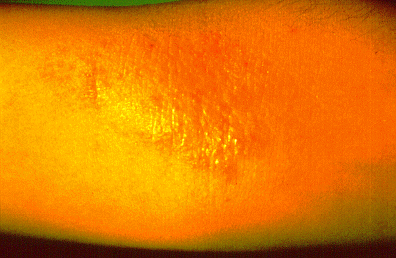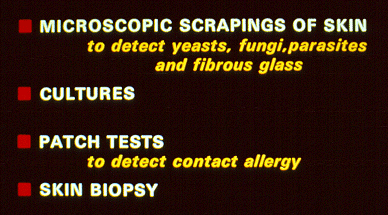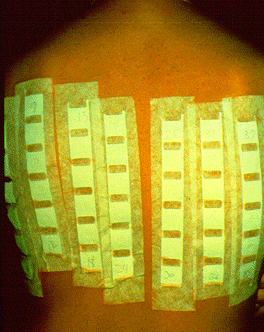Occupational Dermatoses
NOTE: This page is archived for historical purposes and is no longer being maintained or updated.
Slides 96 to 100
Slide 96 - Epoxy resin mixing, poor work practice
This photo was removed due to privacy concerns.
Poor work practices can be an overriding factor in causing occupational skin disease. Mixing epoxy resin paints in a closed space creates a potential hazard for vapor inhalation as well as skin contact.
Slide 97 - Atopic

Atopic individuals are predisposed to develop dermatitis from marginal irritants. These individuals usually have a personal or family history of hayfever, sinusitis, asthma or childhood eczema. Flares of atopic dermatitis are common in industrial environments that cause individual skin irritation. However, the atopic individual is not predisposed to allergic contact dermatitis.
Slide 98 - Work History
This photo was removed due to privacy concerns.
Obtaining a detailed history of work exposures as part of a medical record is essential in making a dignosis of occupational skin disease. Following a careful medical examination, there are a number of studies which may need to be done depending on the diagnosis in question.
Slide 99 - Diagnostic Studies

The studies may include:
(1) Microscopic scrapings of skin to detect yeasts, fungi, parasites and fibrous glass;
(2) Cultures;
(3) Patch tests to detect contact allergy;
(4) Skin biopsy.
Slide 100 - Patch test

A patch test is a bioassay for the definitive diagnosis of delayed hypersinsitivity of the allergic contact type. The test is performed by applying a non-irritation concentration of the substance to unaffected skin for 48 hours. The test should not be performed unless one has had sufficient experience with this procedure as there are a number of possibilities for both false positive and false negative reactions. Diagnostic patch testing is not used for testing direct irritants. The key to interpreting patch test reactions is to determine the relevance of the reaction to the patient's environment. Routine pre-placement patch testing is not recommended.
- Page last reviewed: January 5, 1998 (archived document)
- Content source:
- National Institute for Occupational Safety and Health Health Effects Laboratory Division (HELD)


 ShareCompartir
ShareCompartir